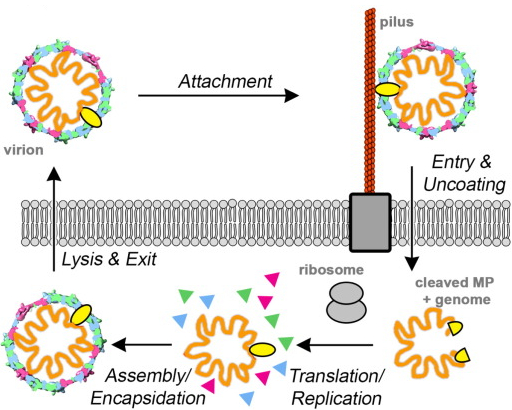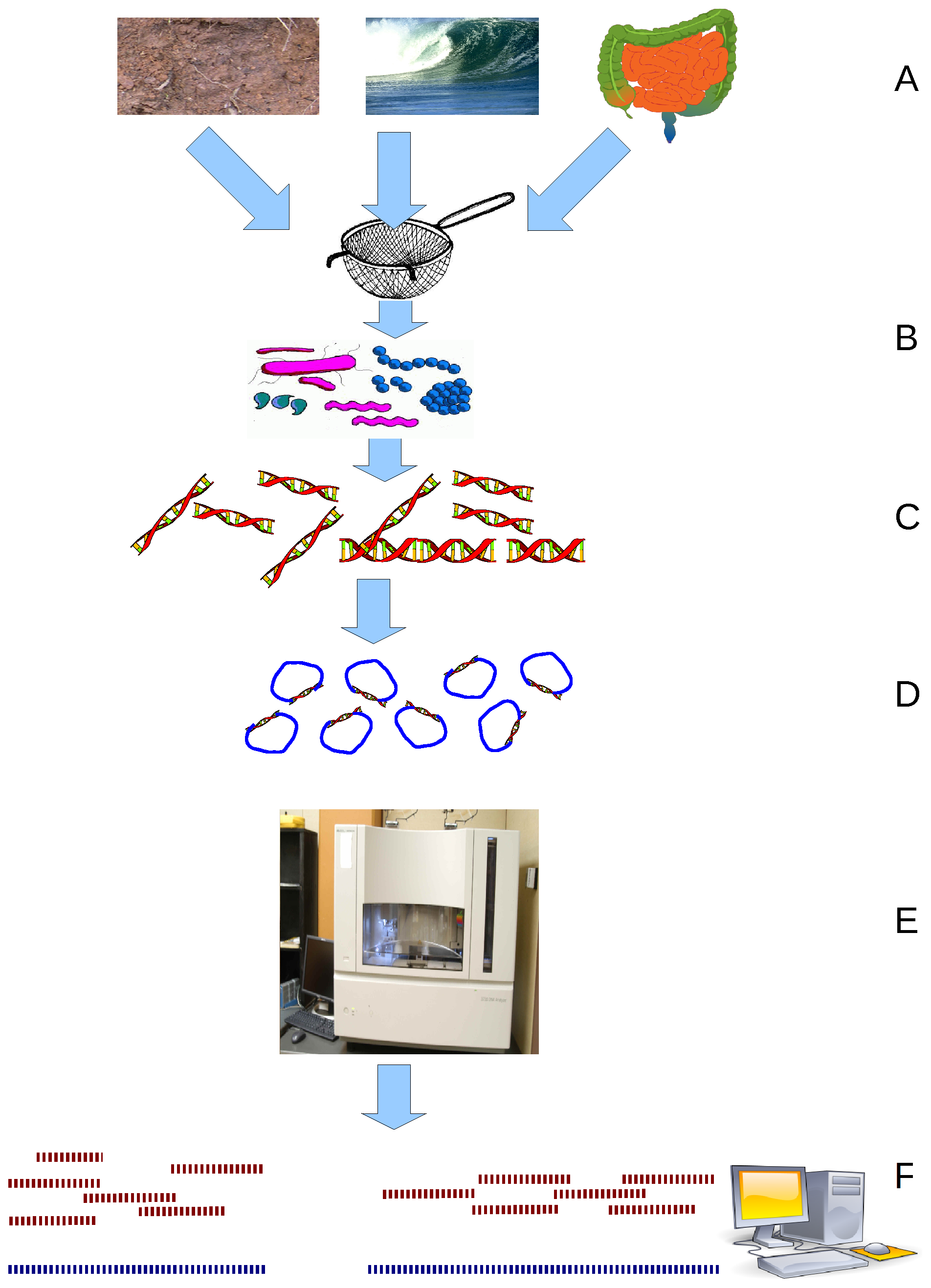|
Norzivirales
''Norzivirales'' is an order of viruses, which infect prokaryotes. Most of these bacteriophages were discovered by metagenomics. Taxonomy ''Norzivirales'' contains the following four families: * ''Atkinsviridae'' * '' Duinviridae'' * ''Fiersviridae'' * ''Solspiviridae ''Solspiviridae'' is a family (biology), family of RNA viruses, which infect prokaryotes. Taxonomy ''Solspiviridae'' contains 24 genera: * ''Alohrdovirus'' * ''Andihavirus'' * ''Dibaevirus'' * ''Dilzevirus'' * ''Eosonovirus'' * ''Etdyvivirus ...'' References Virus orders {{virus-stub ... [...More Info...] [...Related Items...] OR: [Wikipedia] [Google] [Baidu] |
Bacteriophages
A bacteriophage (), also known informally as a ''phage'' (), is a duplodnaviria virus that infects and replicates within bacteria and archaea. The term was derived from "bacteria" and the Greek φαγεῖν ('), meaning "to devour". Bacteriophages are composed of proteins that encapsulate a DNA or RNA genome, and may have structures that are either simple or elaborate. Their genomes may encode as few as four genes (e.g. MS2) and as many as hundreds of genes. Phages replicate within the bacterium following the injection of their genome into its cytoplasm. Bacteriophages are among the most common and diverse entities in the biosphere. Bacteriophages are ubiquitous viruses, found wherever bacteria exist. It is estimated there are more than 1031 bacteriophages on the planet, more than every other organism on Earth, including bacteria, combined. Viruses are the most abundant biological entity in the water column of the world's oceans, and the second largest component of biomass ... [...More Info...] [...Related Items...] OR: [Wikipedia] [Google] [Baidu] |
Atkinsviridae
''Atkinsviridae'' is a family of RNA viruses, which infect prokaryote A prokaryote () is a single-celled organism that lacks a nucleus and other membrane-bound organelles. The word ''prokaryote'' comes from the Greek πρό (, 'before') and κάρυον (, 'nut' or 'kernel').Campbell, N. "Biology:Concepts & Connec ...s. Taxonomy ''Atkinsviridae'' contains 56 genera: * '' Andhevirus'' * '' Apihcavirus'' * '' Arihsbuvirus'' * '' Bahdevuvirus'' * '' Bilifuvirus'' * '' Blinduvirus'' * '' Cahtebovirus'' * '' Chinihovirus'' * '' Chounavirus'' * '' Cihsnivirus'' * '' Diydovirus'' * '' Dugnivirus'' * '' Firunevirus'' * '' Gohshovirus'' * '' Hehspivirus'' * '' Helacdivirus'' * '' Hirvovirus'' * '' Huhmpluvirus'' * '' Huleruivirus'' * '' Hysdruvirus'' * '' Ichonovirus'' * '' Ipivevirus'' * '' Isoihlovirus'' * '' Kempsvovirus'' * '' Kihrivirus'' * '' Kimihcavirus'' * '' Kudohovirus'' * '' Kuhfotivirus'' * '' Lahcomavirus'' * '' Lehptevirus'' * '' Lobdovirus ... [...More Info...] [...Related Items...] OR: [Wikipedia] [Google] [Baidu] |
Duinviridae
''Duinviridae'' is a family of RNA viruses ''Orthornavirae'' is a kingdom of viruses that have genomes made of ribonucleic acid (RNA), those genomes encoding an RNA-dependent RNA polymerase (RdRp). The RdRp is used to transcribe the viral RNA genome into messenger RNA (mRNA) and to repli ..., which infect prokaryotes. Taxonomy ''Duinviridae'' contains 6 genera: * '' Apeevirus'' * '' Beshanovirus'' * '' Kahshuvirus'' * '' Kohmavirus'' * '' Samuneavirus'' * '' Tehuhdavirus'' References Virus families Riboviria {{virus-stub ... [...More Info...] [...Related Items...] OR: [Wikipedia] [Google] [Baidu] |
Fiersviridae
''Fiersviridae'' is a family of positive-strand RNA viruses which infect prokaryotes. Bacteria serve as the natural host. They are small viruses with linear, positive-sense, single-stranded RNA genomes that encode four proteins. All phages of this family require bacterial pili to attach to and infect cells. The family has 185 genera, most discovered by metagenomics. In 2020, the family was renamed from ''Leviviridae'' to its current name. Structure Viruses in ''Fiersviridae'' are non-enveloped, with icosahedral and spherical geometries, and T=3 symmetry. Their virion diameter is around 26 nm. Genome Fiersviruses have a positive-sense, single-stranded RNA genome. It is linear and non-segmented and around 4kb in length. The genome encodes four proteins, which are the coat, replicase, maturation, and lysis protein. Life cycle Entry into the host cell is achieved by adsorption into the host cell. Replication follows the positive-strand RNA virus replication model. Positive-s ... [...More Info...] [...Related Items...] OR: [Wikipedia] [Google] [Baidu] |
Solspiviridae
''Solspiviridae'' is a family (biology), family of RNA viruses, which infect prokaryotes. Taxonomy ''Solspiviridae'' contains 24 genera: * ''Alohrdovirus'' * ''Andihavirus'' * ''Dibaevirus'' * ''Dilzevirus'' * ''Eosonovirus'' * ''Etdyvivirus'' * ''Fahrmivirus'' * ''Hinehbovirus'' * ''Insbruvirus'' * ''Intasivirus'' * ''Jargovirus'' * ''Mahshuvirus'' * ''Mintinovirus'' * ''Odiravirus'' * ''Oekfovirus'' * ''Puhrivirus'' * ''Puirovirus'' * ''Sexopuavirus'' * ''Thiuhmevirus'' * ''Tohkunevirus'' * ''Tyrahlevirus'' * ''Vendavirus'' * ''Voulevirus'' * ''Wishivirus'' References Virus families Riboviria {{virus-stub ... [...More Info...] [...Related Items...] OR: [Wikipedia] [Google] [Baidu] |
Order (biology)
Order ( la, wikt:ordo#Latin, ordo) is one of the eight major hierarchical taxonomic ranks in Linnaean taxonomy. It is classified between Family_(biology), family and Class_(biology), class. In biological classification, the order is a taxonomic rank used in the classification of organisms and recognized by the nomenclature codes. An immediately higher rank, superorder, is sometimes added directly above order, with suborder directly beneath order. An order can also be defined as a group of related families. What does and does not belong to each order is determined by a taxonomist, as is whether a particular order should be recognized at all. Often there is no exact agreement, with different taxonomists each taking a different position. There are no hard rules that a taxonomist needs to follow in describing or recognizing an order. Some taxa are accepted almost universally, while others are recognized only rarely. The name of an order is usually written with a capital letter. Fo ... [...More Info...] [...Related Items...] OR: [Wikipedia] [Google] [Baidu] |
Virus
A virus is a submicroscopic infectious agent that replicates only inside the living cells of an organism. Viruses infect all life forms, from animals and plants to microorganisms, including bacteria and archaea. Since Dmitri Ivanovsky's 1892 article describing a non-bacterial pathogen infecting tobacco plants and the discovery of the tobacco mosaic virus by Martinus Beijerinck in 1898,Dimmock p. 4 more than 9,000 virus species have been described in detail of the millions of types of viruses in the environment. Viruses are found in almost every ecosystem on Earth and are the most numerous type of biological entity. The study of viruses is known as virology, a subspeciality of microbiology. When infected, a host cell is often forced to rapidly produce thousands of copies of the original virus. When not inside an infected cell or in the process of infecting a cell, viruses exist in the form of independent particles, or ''virions'', consisting of (i) the genetic material, i. ... [...More Info...] [...Related Items...] OR: [Wikipedia] [Google] [Baidu] |
Prokaryote
A prokaryote () is a single-celled organism that lacks a nucleus and other membrane-bound organelles. The word ''prokaryote'' comes from the Greek πρό (, 'before') and κάρυον (, 'nut' or 'kernel').Campbell, N. "Biology:Concepts & Connections". Pearson Education. San Francisco: 2003. In the two-empire system arising from the work of Édouard Chatton, prokaryotes were classified within the empire Prokaryota. But in the three-domain system, based upon molecular analysis, prokaryotes are divided into two domains: ''Bacteria'' (formerly Eubacteria) and ''Archaea'' (formerly Archaebacteria). Organisms with nuclei are placed in a third domain, Eukaryota. In the study of the origins of life, prokaryotes are thought to have arisen before eukaryotes. Besides the absence of a nucleus, prokaryotes also lack mitochondria, or most of the other membrane-bound organelles that characterize the eukaryotic cell. It was once thought that prokaryotic cellular components within the cytop ... [...More Info...] [...Related Items...] OR: [Wikipedia] [Google] [Baidu] |
Metagenomics
Metagenomics is the study of genetic material recovered directly from environmental or clinical samples by a method called sequencing. The broad field may also be referred to as environmental genomics, ecogenomics, community genomics or microbiomics. While traditional microbiology and microbial genome sequencing and genomics rely upon cultivated clonal cultures, early environmental gene sequencing cloned specific genes (often the 16S rRNA gene) to produce a profile of diversity in a natural sample. Such work revealed that the vast majority of microbial biodiversity had been missed by cultivation-based methods. Because of its ability to reveal the previously hidden diversity of microscopic life, metagenomics offers a powerful lens for viewing the microbial world that has the potential to revolutionize understanding of the entire living world. As the price of DNA sequencing continues to fall, metagenomics now allows microbial ecology to be investigated at a much greater scale ... [...More Info...] [...Related Items...] OR: [Wikipedia] [Google] [Baidu] |



